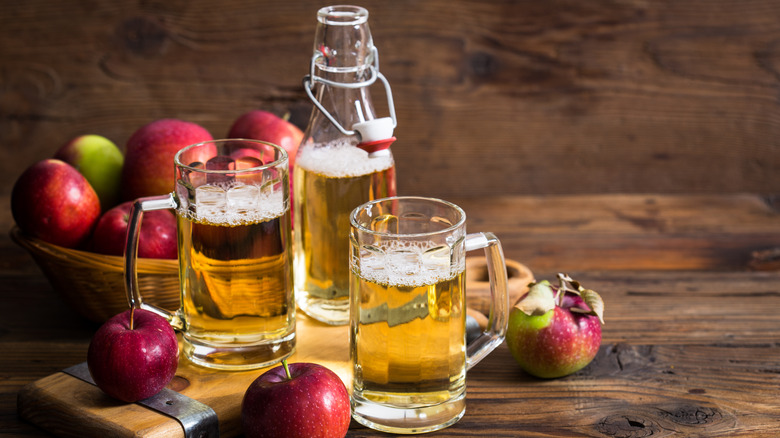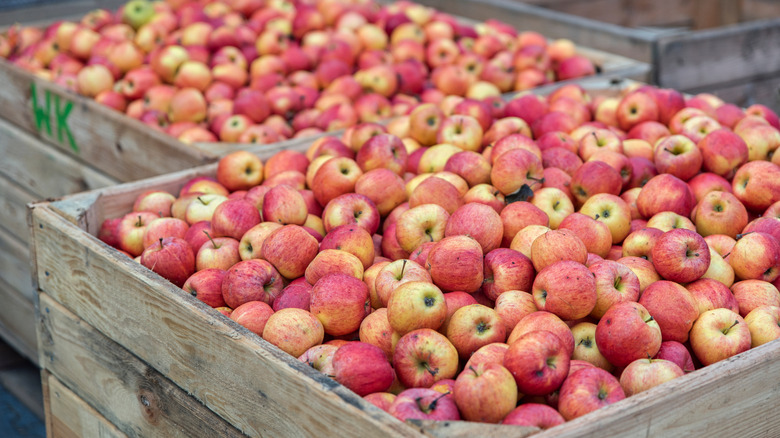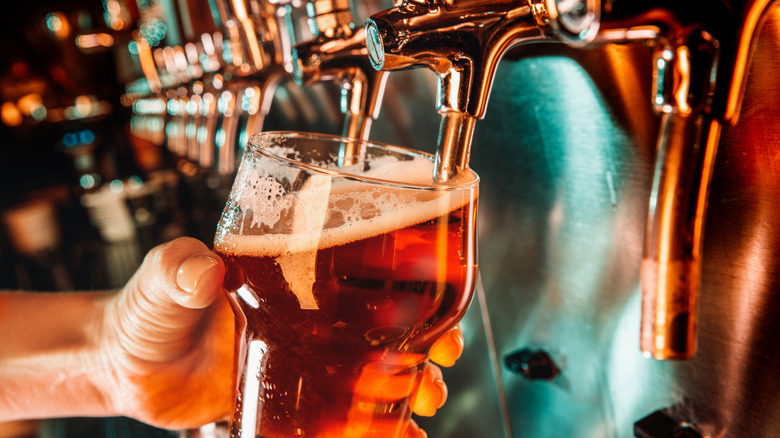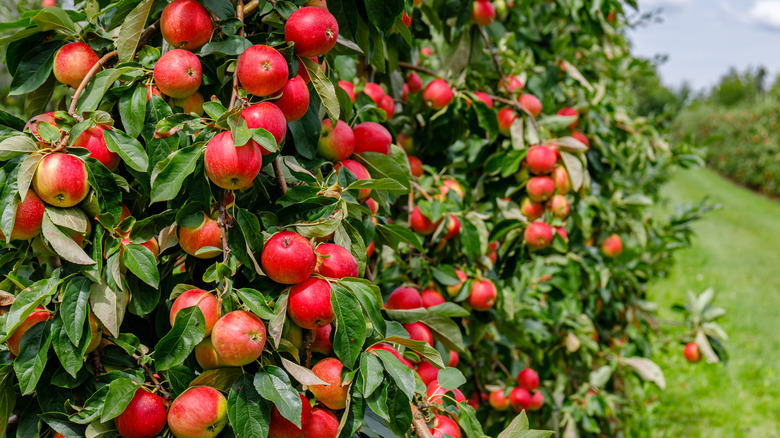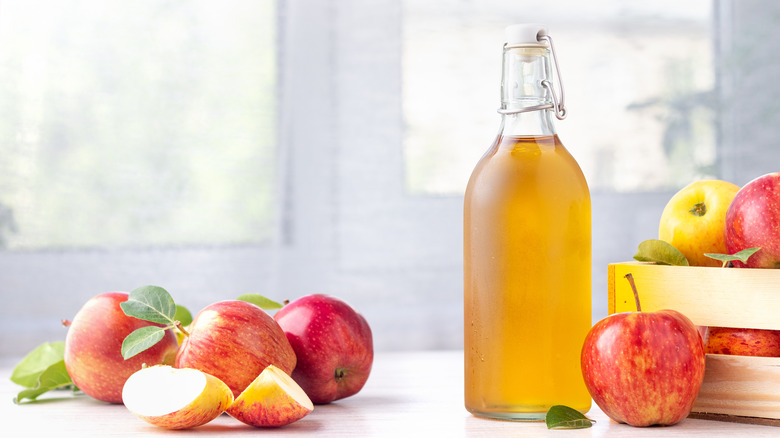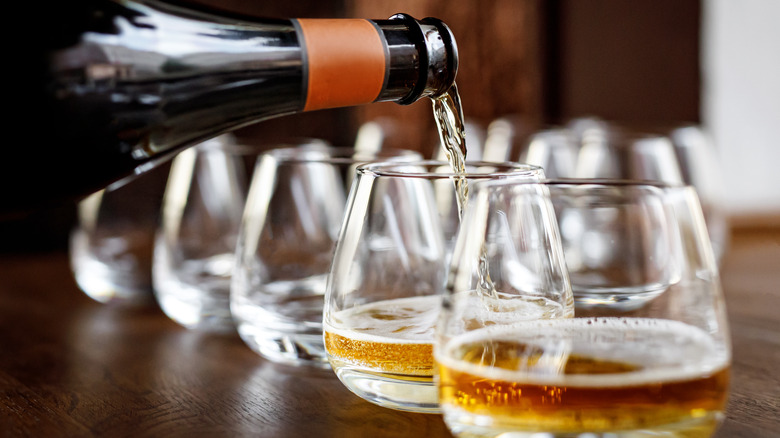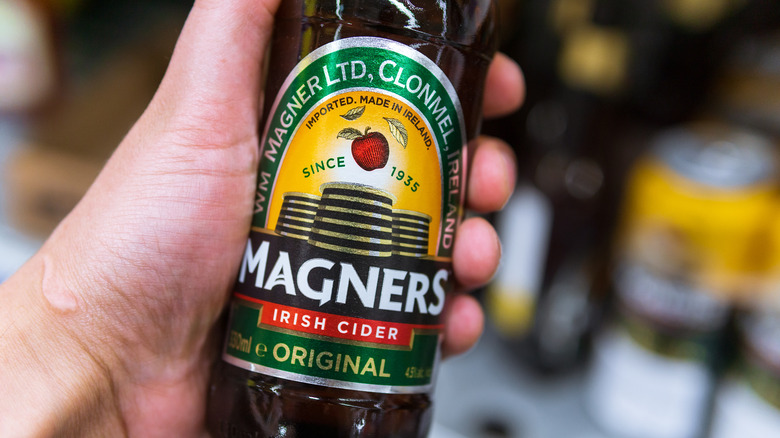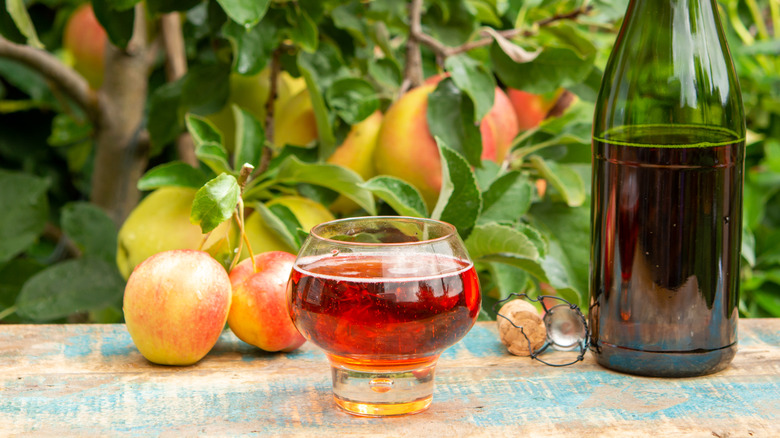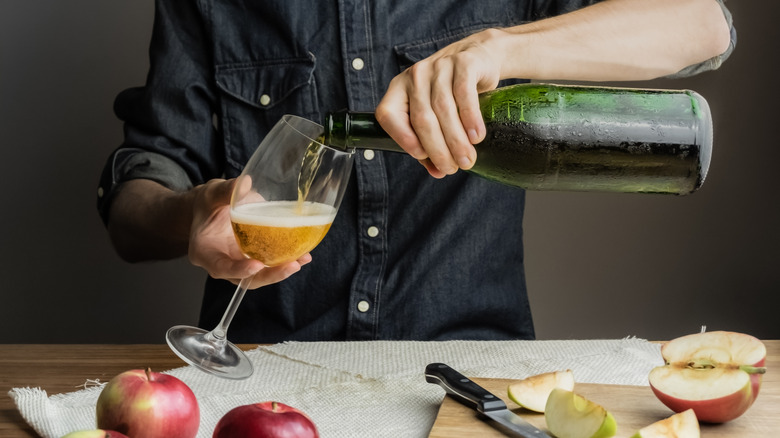Everything You Need To Know About Cider
Cider is a delicious drink option any time of year, but it doesn't get as much play as the usual choices of beer, wine, and liquor. Those drinks normally dominate the conversation year-round, while cider's popularity is mostly relegated to the fall. But that wasn't always the case.
The main reason cider doesn't receive the same attention as other spirits is because of Prohibition. Before the 1920s, cider was actually one of the most common alcoholic beverages in the United States. It was so common, in fact, that entering someone's home in an orchard-rich state like New York would most likely be followed by a casual offering of cider. Cider production saw an intense drop with Prohibition, however, and seemed to permanently disappear even after the law was repealed.
Luckily, with the craft beer Renaissance of the 21st century, cider has made quite the comeback in the craft and local season, with some brands growing to nationwide consumption. The cider market has grown into a $553.6 million industry as of 2021, which is an astounding $36 million increase from before the COVID-19 pandemic (via Northeastern University). With cideries continuing to pop up and more and more brands stacking liquor store shelves, here is everything you need to know to venture into the world of cider with a headstart, and why the reinvigorated beverage is the unsung hero of the autumn season and beyond.
Is cider beer or wine?
The real answer is neither — cider is completely its own thing. The fundamental difference between these three different beverages is their different foundations. Beer is produced through the fermentation of malted grains and is flavored with hops, wine is produced through the fermentation of juice pressed from grapes, and cider is produced through the fermentation of juice pressed, usually, from apples.
The differences between the three go even further, however, in regard to things like flavor, alcohol content, variety, etc. For example, although cider is fermented from fruit, just like wine, it generally carries a far lower ABV. The alcohol content of cider usually sits around 5%, similar to most beer, while the ABV of wine is usually at least 12%.
Plus, beer can be divided into the two categories of ale or lager, each requiring different ingredients and fermentation methods. In the world of wine, there are countless styles that can be separated into specific grape species, countries, regions, and many other factors. This is contrary to cider, which is made the same regardless of whether it's produced from apples or pears. No matter the flavoring additives utilized, ciders remain a more straightforward beverage in the big picture.
How is cider made?
As is the case with any food or drink, everything starts with and is made better with quality, fresh ingredients. Most of the apples you find at the supermarket or in an orchard are not suitable for cider making, however. Those are cooking or eating apples, of which there are many popular types. According to Cider Scene, cider apples can be categorized as sweet, sharp, bittersharp, and bittersweet. These apples are better for making cider because of their varying levels of acids and tannins, which are combined accordingly to make the desired cider.
Once selected, the apples are then cleaned thoroughly before being ground down into a pulp. The pulp is then squeezed either mechanically or by hand, and the remaining liquid moves onto the next step of fermentation. Because the juice contains natural sugars, that means natural fermentation. The liquid is heated to between 40 and 60 degrees Fahrenheit, at which point it can kill off its natural yeast so the producer can add cider yeast if necessary.
After the first fermentation is complete, the liquid is separated from the yeast left behind and moved to a clean, airless vat. This step is called racking and is what makes cider clear. Another fermentation then takes place, after which the cider is carbonized and can either be sweetened, flavored, or sipped as is for some crisp, tasty enjoyment.
Which is healthier — beer or cider?
If you are mindful of the nutrition of whatever you eat or drink, it's worthwhile to compare cider to beer, since they're closely related counterparts. Per Crafty Nectar, cider contains natural compounds called polyphenols that improve blood pressure and cholesterol. These are not found in beer, but beer can improve digestion (as is the case with any fermented beverage). As far as vitamins go, beer and cider are pretty much on the same level. Beer contains vitamins like magnesium, potassium, and vitamin B, while cider also has vitamin B, as well as vitamin C and folic acid.
Sugar is a big — and sometimes overlooked — factor people consider when thinking about the health aspects of drinking. Predictably, beer contains far less sugar than cider. Although the amount of calories is about the same, the typical beer contains no added sugar while cider usually does. A basic, dry cider will not contain any sugar at all, but most ciders that are sold commercially do in fact contain quite a bit of added sugar.
Overall, cider and beer are quite similar in terms of healthiness. Both have their benefits, but these are only salvageable when enjoyed in moderation. Overdoing it with any type of alcohol will surely diminish any possible health benefits and do more harm than good.
Origins of cider
The natural fermentation to develop alcohol is actually how cider was first discovered. Much like mead, another beverage that dates back to ancient times, cider was discovered by accident around the year 1300 B.C., according to Cider Scene. The juice pressed from apples was commonly enjoyed in ancient times and the natural development of alcohol that occurred over time was not done on purpose. However, those who discovered its effect were pleased with it, and so the method was replicated and practiced.
These early forms of cider were not the same as what is common today. In fact, the clean, clear cider we recognize nowadays did not become as such until about the 13th century across Europe. This modern cider was eventually brought over to what is now the United States during the age of exploration and discovery of the New World, but apples were not a natural crop in North America, so settlers had to establish their own orchards. Colonists imported massive amounts of bees to pollinate the land to the level necessary to grow the crop. Apple orchards developed and grew throughout this period, and cider actually became a very popular beverage among the American founding fathers, many of whom owned their own orchards for cider making.
What makes apple cider different from apple juice?
Now that we have a clear understanding of what cider is, let's be sure to not have cider for adults confused with apple juice, a childhood staple. Of course, cider is fermented to generate alcohol after the apples have been pressed, but the liquid that is pressed out of the apple pulp is not apple juice.
If you have ever gotten apple cider from a farmer's market or the grocery store, that is liquid pressed from the apple pulp. This super fresh and delicious drink is the perfect non-alcoholic beverage for the autumn season, and warming it up and drinking it from a mug is even better.
The apple juice that is found inside the iconically branded plastic bottle or juice boxes is the liquid pressed from the apple pulp that has undergone a filtration process and pasteurization. Filtration is performed to clarify the liquid further, and pasteurization is a process done to extend shelf life. Also, many apple juices bought in the supermarket are artificially sweetened, whereas pure apple cider is not. Apple cider does not have a very long shelf life, however, and can actually begin to ferment into a hard cider if not refrigerated properly.
The many flavors of cider
Now that cider is broken into the mainstream and is here to stay, it's important to understand its many forms and what that means for developing your own taste.
As far as styles go, there are four different kinds of cider that are classified based on sugar content, per 52 Brews. Dry ciders are the most common and have the lowest sugar content at less than 0.5% residual sugar, so they taste more acidic. However, this lower amount of residual sugar does mean dry ciders can have ABVs up to 7%. Off-dry ciders contain slightly more sugar (between 1 and 2%) and are known for their rich flavorings and smooth mouthfeel and finish. Semi-dry ciders have a residual sugar content of over 2%, which means that are sweeter and carry a more noticeable apple flavor, and semi-sweet ciders take this even further with sugar contents of over 4%.
As mentioned earlier, cider can be made from apples or pears, but the flavorings can pretty much be endless. Many may think of cider as a fall drink, but this open door of flavoring potential is what can make cider fit all year round. For example, Burnt Mills Cider in Bedminster, NJ produces and sells a Fall Spice cider for the autumn season, as well as blueberry-flavored cider for the summer months. Once you figure out what sweetness level you're after, delving into flavored ciders out there is what makes trips to cideries so much fun.
How cider varies from country to country
Cider varieties in the United States alone do not differ very much from one region to the next. Different apple-growing states may produce different species of apples, but the cider-making method is universal throughout the country. There are differences, however, in cider that comes from various parts of the world, per The Crafty Cask.
For example, ciders from France — the world's largest producer of the beverage — are generally very light and slightly sweet. French ciders can either be "brut," which is dry and has more alcohol, or "doux," which is sweeter and has less alcohol. Most French cider is made in Normandy and Brittany in the northern portion of the country.
Spain is another big cider producer, but the cider made there is more acidic, with almost vinegar-like qualities. These are mainly produced in Asturias and Basque, are unfiltered, and are so tart you may think you've gotten a bad batch at first sip. Spanish cider is an acquired taste, but giving it a fair shot will reveal very nuanced flavor profiles and aromas, similar to earthy Spanish wine.
In the United Kingdom, cider is so popular that more than half of the apples grown are used for cider making. The U.K. actually drinks more cider than any other country in the world. Cider in the U.K. can be separated by east and west, the east producing sweeter ciders with more alcohol, and the west producing cloudy, unfiltered, uncarbonated ciders that are very dry.
What to look for when shopping for cider
Once you know what you are looking for, shopping for cider at your local liquor store will most likely provide a plethora of options. While it is always encouraged to look for and support small businesses, there may not always be local craft cider on the shelves.
There are several popular hard cider brands, but the one that is most widely available is probably Angry Orchard. Produced in Walden, New York, Angry Orchard is considered a great entry point for cider newcomers. Their four flagship flavors include crisp apple, easy apple, rose, and pear, each of which sits at around 5% alcohol content.
Another great brand that is well-established and accessible is Woodchuck Cider, from Middlebury, Vermont. Align with the typical classic flavors, Woodchuck also makes Granny Smith as well as a "Pearsecco." In 2011, Woodchuck was actually the highest-selling cider in the U.S., claiming roughly 47% of the market.
Another cider brand that is growing exponentially in popularity is 1911 Established. Also produced in upstate New York, 1911 has a wide array of flavors that are canned and distributed, including a sour hibiscus cider and a cider donut flavor. Their original is definitely their most popular and is well worth a try as well if you happen to come across it.
What glassware to use when drinking cider
Just like with wine, liquor, or different styles of beer, glassware matters. Of course, drinking it straight from the can is not going to make it taste bad. However, drinking cider, or any alcohol for that matter, in a glass specifically made for it will enhance the experience in more ways than one.
According to Cider Culture, the best glassware for drinking cider is hard cider glass. These look similar to IPA glasses but are wider on top. The top portion is almost the shape of a bowl with a very wide rim and round body that narrows slightly towards the bottom. A ribbed, narrow handle sits underneath. This unique shape allows for plenty of room for the cider, so you can enjoy all of the aromas with every sip. Plus, cider glasses allow for the bubbles inside to last longer, so you don't have to worry about it turning flat before you have finished.
Another glassware that makes a great vessel for cider is a Belgian-style beer glass with a round body and short stem, almost like a tulip shape. Wine glasses also work well for cider and are something you likely don't need to go purchase.
All three of these options not only have concrete, noticeable factors that help preserve and promote the character of the cider, but sipping cider from such a glass will put you in the right mindset to enjoy your drink more thoroughly.
What food to pair with cider
Because of cider's obvious apple-forward flavor profile, it only makes sense that the best foods to pair with it are also common foods of the fall season (via Eat North). This means classic autumn favorites like apple pie and apple cider doughnuts and pumpkin staples like pumpkin pie. Also, the fall season is soup season, and a hearty soup like butternut squash soup or vegetable soup is the perfect duo to be shared with a crisp cider.
If you're a cider drinker at all times of the year, you can pair cider with food the same way you might white wine or light beer. Creamy pasta dishes, fish, and poultry can all be enhanced by a cider, as well as bar-style food such as pizza, wings, burgers, or whatever you might enjoy with a basic lager. Really, the most important thing is to enjoy cider with whatever makes you happy. There are no concrete rules for how to drink cider or what to drink it with. Above anything else, feed your preference.
How should cider be stored?
Cider packaged in a can or glass bottle will last indefinitely, but it is best enjoyed within two years of its production. If you make a trip to New York or another state ripe with quality cider and take advantage by buying some in bulk, storage is key to ensure it will keep its character well.
Cider doesn't need to be refrigerated, but it is the simplest and most consistent way to store it. According to Medium, the best way to store cider is in a cool, dry, dark place. This usually means in your garage, but the temperature in a garage can change with the seasons depending on where you live. Storing your cider inside your house is dependent on how you utilize your heating or cooling, so finding that sweet spot either in your house or garage may take some more thought than you anticipated. The most important tip is to keep your cider away from direct sunlight.
Again, the refrigerator is your best bet for your cider, but keep this next slide in mind when you decide to crack one open.
Avoid drinking really cold cider
Another simple way to get the most out of a cider is to pay attention to its temperature. According to Cider Culture, extreme cold is quick to overpower and lessen the flavor profile and aromatics in any beverage, but a frosty beer will retain more of its flavor and character than an ice-cold cider. This is because the aromas and flavor of cider are more delicate and they are not able to stand up to extreme cold as other beverages might.
To enjoy everything a cider has to offer, do your best to drink it when it has reached a temperature between 50 and 55 degrees Fahrenheit. In order to achieve this, remove your cider from the refrigerator and let it sit at room temperature for about five minutes. Once it warms up just a bit, pouring it into a room-temperature glass will bring it up to the perfect temperature for enjoyment. This is a similar practice to white wine, which drinkers are recommended to let "open up" using the same method.
